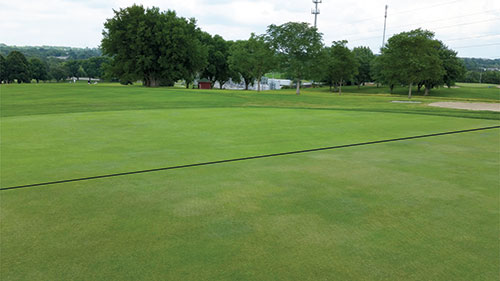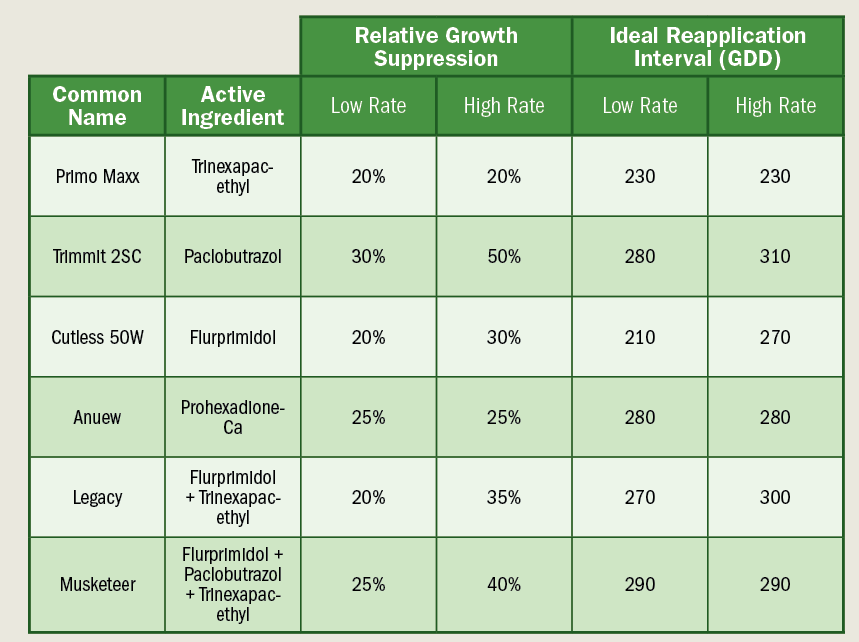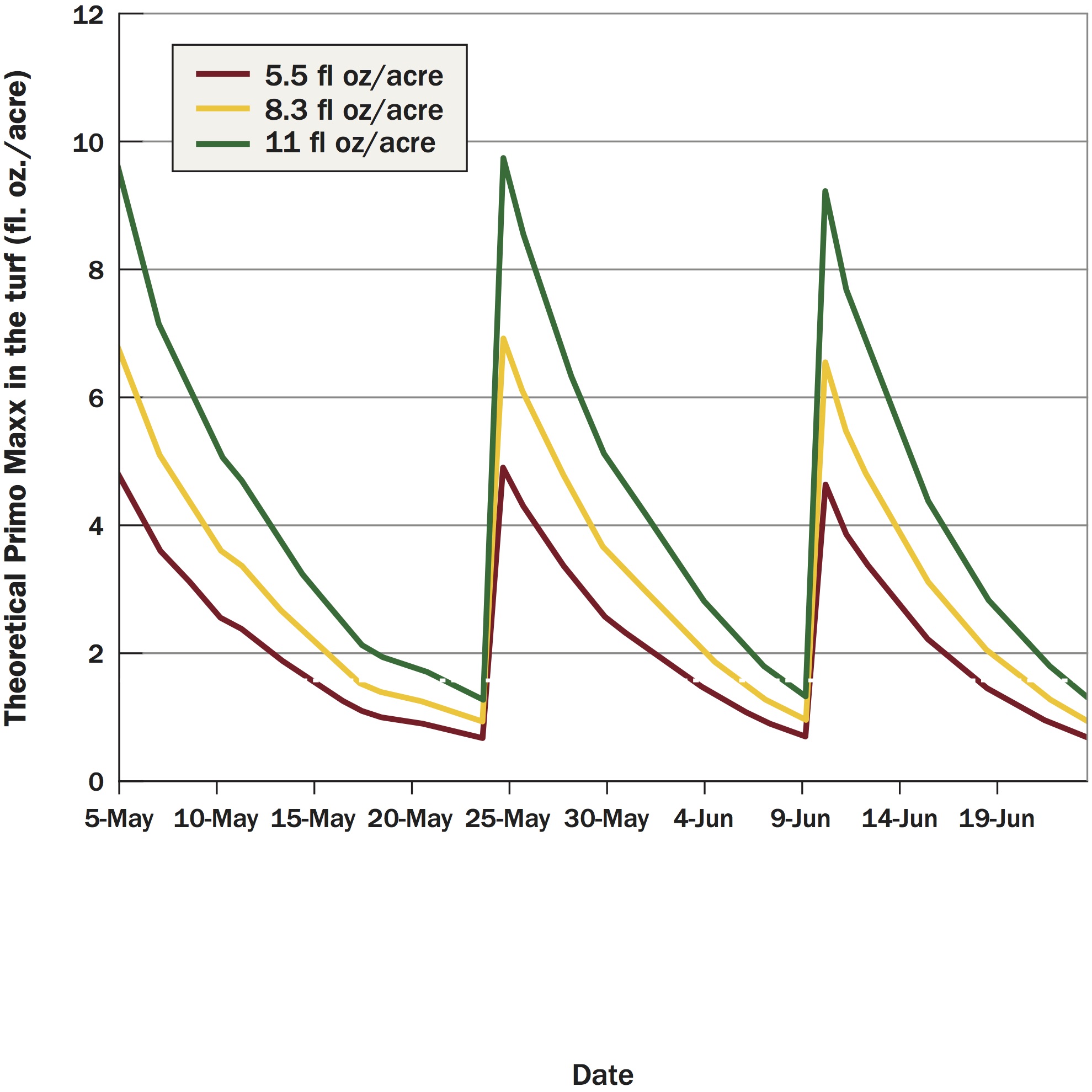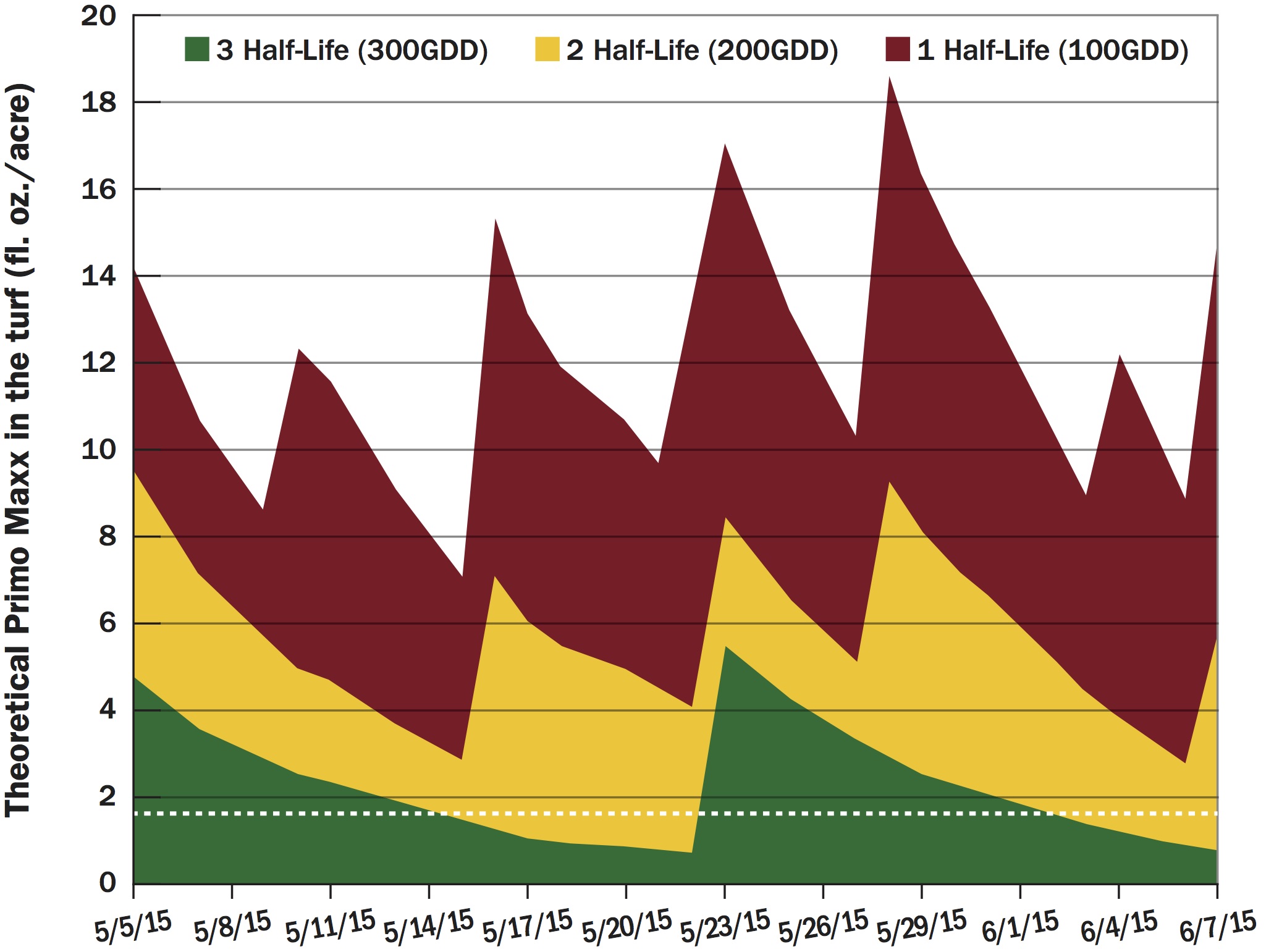The perils of PGR over-regulation
The benefits of plant growth regulators (PGRs) have been touted for decades and with good reason. Research shows that PGRs can reduce clipping yield, increase turf quality and performance and improve stress tolerance.

The foreground shows an annual bluegrass/creeping bentgrass green treated with both Trimmit (2 oz./acre) and Primo Maxx (6 oz./acre) every five to 10 days. The background section of the green had the same maintenance but did not receive the PGR mix. The turf in the foreground has typical signs of PGR over-regulation, including patches of discolored turf, leaf segregation and worn-leaf tips.
To sustain these benefits, growth regulators need frequent re-application throughout the year. As a result, many superintendents have tightened their application intervals down to a week or less during the summer. Most will also use a lower application rate to increase safety. Other superintendents like to combine different stand-alone PGR products to increase control and provide greater safety. While the concepts are sound, these PGR programs can result in too much of a good thing: PGR over-regulation.
Can turfgrass be over-regulated by gibberellin-inhibiting PGRs, and what does that really mean? It depends on the demand of the turfgrass stand. For example, turf grown under a fence line or around tree bases typically has lower demands for quality and performance. It just needs to look decent and grow slowly to reduce the need to string trim.
On the other hand, a golf putting green needs some amount of daily growth to recover from traffic, disease or other pest damage. In these cases, too much growth suppression from a PGR can limit recovery and lead to undesirable turf quality and performance. Too much growth suppression also can cause mild discoloration (phytotoxicity) and even segregation of grasses like creeping bentgrass and annual bluegrass, which also is undesirable. This would be a case where PGRs are over-regulating turf growth.
A case study of over-regulation
Over-regulation of turf can resemble other types of stress and often is confused with disease. The turf has a blue-brown color and putting greens have a patchy appearance. On closer inspection, the leaves generally are free of lesions but have a worn appearance with brown, shredded leaf tips. Occasionally, leaves will have lesions from diseases like dollar spot or leaf spot. Last summer I was asked to visit several golf courses with these symptoms, and it was obvious that something wasn’t quite right. Fortunately for me, one of the courses with these symptoms was helping the Nebraska Turf Program with a PGR interseeding study.
As part of the study, half of the No. 2 green was not treated with a PGR except for inside the study area. The superintendent would first spray our research area with his normal mix (fertilizer, fungicide, etc.), then would add the PGR mix and spray the rest of his greens. In essence, half of his No. 2 green was a great no-PGR check plot.
It was clear that his PGR program was the culprit. There was a stark line between the treated and non-treated part of this green (Figure 1). Different biotypes of annual bluegrass and creeping bentgrass ranged in color from greenish brown to blue-green. The non-treated side had a bunch of annual bluegrass seedheads, while the seedheads on the treated side were still buried in the canopy and emerged several weeks later.
What was the superintendent spraying to get this response? The superintendent was mixing paclobutrazol at the low-labeled rate with the standard rate of trinexapac-ethyl. I was applying similar rates of both products alone and didn’t see the response. It could have been the mix, because mixing the PGRs increases the amount of growth suppression in our research. Still, we rarely see that type of discoloration when we mix paclobutrazol and trinexapac-ethyl. I asked the superintendent about the re-application interval. He wasn’t using growing degree day (GDD) models and he was re-applying PGRs every five to 10 calendar days. That was the biggest clue, because our research shows that tightening the re-application interval can strengthen growth suppression.
Re-application interval affects performance
The goal of a successful PGR application program is to maintain enough PGR in plant to slow biosynthesis of gibberellin, the plant hormone that accelerates leaf elongation, for the entire growing season. Think of a biosynthetic pathway like a river. Place a dam on the river and it stops downstream flow. A PGR is applied to turf, it dams up the gibberellin biosynthetic pathway and reduces leaf elongation. Repeated applications of PGRs are required because PGRs are broken down over time. This process is dependent on temperature; doubling the air temperature (degrees Celsius) roughly doubles the rate of breakdown. This means that scheduling PGR re-application intervals with a calendar is extremely inefficient because the ideal interval changes with the weather.
An alternative approach to a calendar-based schedule is to use GDD thresholds. A GDD system for PGRs is simply a way to calculate how much heat has been accumulated since a PGR was last applied. Growing degree days are calculated by adding together the daily average temperature (Celsius with a base temperature of 0°C) from the first day the PGR is applied until a re-application threshold has been surpassed. The ideal re-application intervals for trinexapac-ethyl and paclobutrazol on cool-season greens are 200-230 and 270-310 GDD, respectively. When mixing PGRs, use the ideal re-application from the product that lasts longest. That means the ideal re-application interval for the golf course that mixed trinexapac-ethyl and paclobutrazol should have been roughly 300 GDD. That is roughly 20 days in spring and 10 days or less during summer. Again, the superintendent was applying every five to 10 days, or double the frequency required. This can have a huge impact on the amount of PGR inside the plant.
Slow PGR accumulation

Click to enlarge. The impact of PGR active ingredient and application rate on the magnitude and ideal re-application interval (Celsius, base 0°C) for cool-season putting greens. The low- and high-labeled rates represent the lowest and highest application rate specified by each product label for cool-season greens.
Superintendents can use the same GDD system that helps schedule PGR applications to roughly estimate the amount of PGR inside the plant. The ideal interval for trinexapac-ethyl and paclobutrazol is equal to two half-lives. A half-
life is the time is takes for half the PGR to break down inside the plant. That means 50 percent of the trinexapac-ethyl applied to a cool-season putting green is broken down by 100 GDD. After two half-lives (200 GDD) only 25 percent of the product still is active in the plant, and growth suppression starts to wane. Our PGR GDD research shows that rate has minimal impact on the ideal re-application interval.
On cool-season greens for example, the high rate of paclobutrazol, 16 fl. oz. Trimmit/acre, only increased the ideal re-application interval 40 GDD compared to the low rate, 5.5 fl. oz. Trimmit/acre. That’s only 1.5 calendar days of control but three times the active ingredient when the high and low air temperatures are 90 and 70°F, respectively. That same result applies to all the PGRs we’ve tested. The amount of suppression increases with higher rates for most products or when products are mixed, but not the longevity of control. Typical GDD re-application intervals and the relative growth suppression for cool-season greens are summarized in Table 1.

Click to enlarge. The impact of application rate on the longevity of Primo Maxx in a cool-season putting green outside Mead, Neb. The dashed yellow line represents the critical level where growth suppression starts to wane.
The half-life concept helps explain why application rate has a minimal impact on PGR longevity. Another example, the Primo Maxx label, allows for application rates ranging from 5.5 to 11 fl. oz./acre (0.125 to 0.250 fl. oz./1,000 ft2). Figure 2 shows how much theoretical Primo Maxx is in the turf plant based on real weather data from our research station in Nebraska. The red line indicates the low rate and the green line indicates the high rate of Primo Maxx in the plant. The white line is the critical amount of PGR required to suppress growth. Notice how the big differences in Primo Maxx quantity quickly decay and begin to converge together at the white critical point line. Also notice that the Primo Maxx quantity decays faster in June than May because it was cooler in late May. It’s clear why increasing application rate has a minimal impact on PGR longevity. It’s more important to apply more frequently (at two half-lives) to maintain growth suppression.
The half-life concept also explains how applying PGRs too frequently can lead to an accumulation of active ingredient in the plant tissue, even at low application rates. Let’s tweak the thought experiment from the previous paragraph.

Click to enlarge. The influence of re-application interval on the amount of Primo Maxx in a cool-season putting green outside Mead, Neb. Re-applying every two half-lives maintains consistent levels of Primo, while the three half-life interval doesn’t sustain sufficient Primo Maxx to sustain suppression and the one half-life interval leads to Primo accumulation in the plant. This can result in deep growth suppression and the potential for over-regulation.
Instead of three Primo Maxx application rates, we’ll re-apply the 5.5 fl. oz./acre rate every 100, 200 or 300 GDD (one, two or three half-lives). The 200- and 300-GDD intervals causes the amount of Primo Maxx in the plant to increase to roughly 5.5 oz./acre immediately after application, but the Primo Maxx in the 300-GDD interval drops below the critical value (Figure 3). This interval doesn’t sustain growth suppression. The 100-GDD interval does the opposite. That interval causes the amount of Primo Maxx to increase in the plant. After a couple re-application cycles, the amount of Primo Maxx in the turf is double the amount that would be in the plant if it were re-applied every 200 GDD, two half-lives (Figure 3). This happens because Primo Maxx is being applied faster than it’s being broken down. It’s analogous to filling a bucket with a hole in the bottom. If the amount of water poured into the bucket is equal to the amount coming out of the hole, then the water level in the bucket will not change. If the amount of water pouring into the bucket is increased, the water will flow out of the hole slightly faster as the water level in the bucket rises. This essentially is what happens with any PGR applied sooner than two half-lives. It explains why the Nebraska golf course experienced over-regulation. They were applying roughly twice as often as needed. This led to deep and sustained growth suppression.
Ultradwarf bermudagrass over-regulation
Until now, I’ve only referenced cool-season turf at putting-green height. That’s because the data set for that species and environment is the most complete. Early research shows that bermudagrass greens are much more sensitive to PGRs than cool-season greens. The amount of growth suppression and longevity of control is enhanced in bermudagrass. Research is under way to understand which GDD threshold and which base temperature is most appropriate for bermudagrass. While the exact thresholds need to be experimentally determined, the concept about half-lives and PGR accumulation will hold true. Many ultradwarf managers apply Primo Maxx at low rates (2 fl. oz./acre) as frequently as every four days. While that application rate may seem safe and low, it is extremely likely that every four days is less than one half-life. After a couple applications the amount of Primo in the plant starts to accumulate and the risk of over-regulation starts to increase.
GDD models reduce over-regulation
Over-regulation of turf with PGRs can be a real issue, even at low application rates. It often can be confused with disease and intensifies damage from pests and traffic. The best way to sustain season-long growth suppression while avoiding too much growth suppression is to embrace GDD model thresholds to schedule PGR applications. The Nebraska Turf Program has an Excel-based program to help keep track of GDD for cool-season greens (http://turf.unl.edu). We’ve also released a web-based app called GreenKeeper that automatically downloads weather data, calculates GDD and estimates growth suppression for all cool-season turf areas. It’s available free at GreenKeeperApp.com. Several other research labs are working hard to determine GDD thresholds for warm-seasons species under different growing environments. We’re looking forward to incorporating those model data into GreenKeeper next season.
It’s important to understand how PGR re-application intervals and half-lives impact growth suppression. If over-regulation is suspected, stretch out your re-application interval to promote turfgrass recovery. A successful PGR program maintains uniform levels of PGR in the plant throughout the growing season. It maximizes the benefits associated with PGR use and minimizes the risk of too much growth suppression.
Bill Kreuser, Ph.D., is an assistant professor and Extension turfgrass specialist at the University of Nebraska-Lincoln. He can be reached at wkreuser2@unl.edu for more information.
References
Beasley, J. S., and B. E. Branham. 2005. Analysis of paclobutrazol and trinexapac acid in turfgrass clippings. Int. Turfgrass Soc. Res. J. 10:1170-1175.
Kreuser, W. C., and D. J. Soldat. 2011. A growing degree day model to schedule trinexapac-ethyl applications on Agrostis stolonifera golf putting greens. Crop Sci. 51:2228-2236.
McCullough, P. E., H. Liu, L. B. McCarty, and J. E. Toler. 2007. Trinexapac-ethyl application regimens influence growth, quality, and performance of bermudagrass and creeping bentgrass putting greens. Crop Sci. 47: 2138-2144.
Michael, D., G. Obear, and B. Kreuser. 2015. Creating GDD models for commonly applied plant growth regulators. University of Nebraska-Lincoln Turfgrass Research Reports. http://turf.unl.edu/annual-research-reports.
photo: Bill Kreuser









